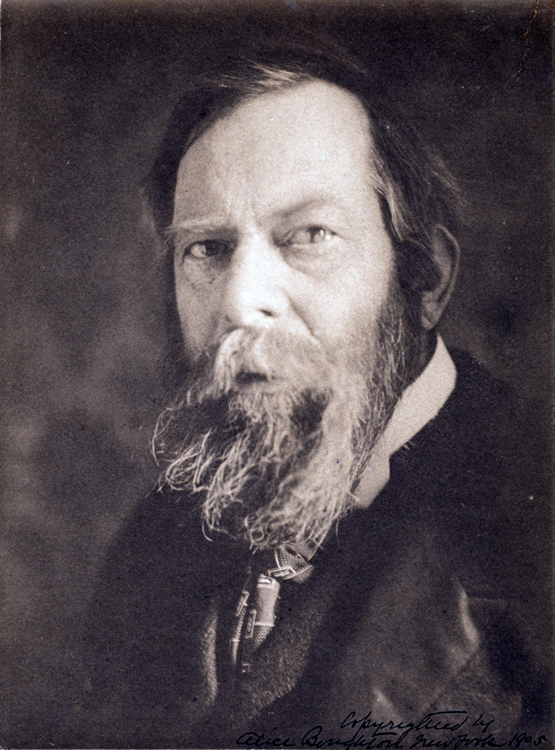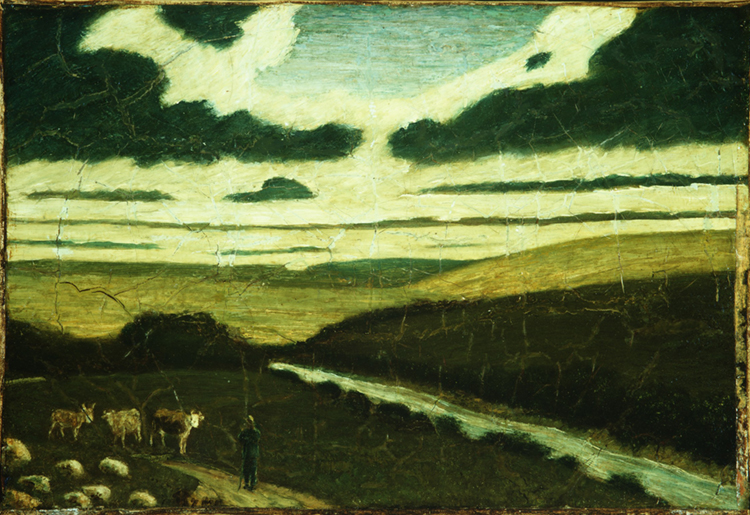Top image: Under a Cloud by Albert Pinkham Ryder. Credit: Under a Cloud (1900), oil on canvas by Albert Pinkham Ryder; Metropolitan Museum of Art
Today, March 28, marks 100 years since the death of American artist Albert Pinkham Ryder (1847-1917). Ryder is considered one of the most original of American painters. He is best known for his brooding night scenes of the sea and dreamlike landscapes. Many of his paintings are based on historical, literary, and religious texts. Ryder conceived simple, bold designs, and he often used dark and pale tones in dramatic contrast. He laid paint on thickly, working on each painting for a long time, creating layers of textured color.
Ryder was born on March 19, 1847, in New Bedford, Massachusetts, a town deeply rooted in the whaling industry of the time. As a youth, Ryder witnessed the constant coming and going of whaling ships, all while hearing harrowing tales of whaling itself. His images of ships on turbulent, nighttime seas serve almost as bleak warnings. At the same time, his landscapes—often with the sea in the background—show a romantic vision of life on land. Regardless of the subject, darkness looms and often dominates Ryder’s creative and strikingly original paintings.

Albert Pinkham Ryder, 1905. Credit: Smithsonian Institution
Ryder had already produced landscapes by the time he moved to New York City in 1870. His maritime fascinations continued in New York, where he studied the play of moonlight on ships sailing the Hudson River. Romantic and independent by nature, Ryder worked in seclusion and was largely self-taught. Ryder did have contact with other artists, however, and he traveled to Europe to study the natural scenes of the French Barbizon and Dutch Hague schools—both strong influences on his later works. Ryder’s imaginative style, which often approaches abstract and modernist design, won critical praise and influenced many other painters.

Landscape by Albert Pinkham Ryder. Credit: Landscape (1897–98), oil on canvas by Albert Pinkham Ryder; Metropolitan Museum of Art
Ryder exhibited paintings from the 1870’s into the early 1900’s, including a well-received showing at New York City’s famous Armory Show in 1913. Ryder’s health began to fail soon after the Armory Show, and he died on March 28, 1917. A memorial exhibition of his work was held the next year at the Metropolitan Museum of Art in New York City, where Ryder’s paintings are still seen today.
Untitled Document Can't view the linked articles? Subscribe to World Book Online

World Book Online delivers a progressive sequence of core databases supported by supplemental
tools, such as language translation, graphic organizers, and unique Webquests. Moving from
Early World of Learning to World Book Advanced, World Book Online aligns end-users with their
appropriate learning levels. Each stand-alone site provides additional features to support the
needs of users’ specific capabilities.
The World Book Difference
World Book combines cutting-edge technology with traditional editorial excellence to produce
authoritative, trustworthy, and unbiased content. The digital content is updated in real time and
carefully curated for each learning level. Accessible 24/7, the content is available on a variety of devices.
World Book Online combines 21st-century instructional techniques with timely information.
By breaking down complex topics and using easily understandable text, World Book Online helps to
build fluency and increase comprehension. Featuring single sign-on capability, these sites are paired
with highly visual content to engage even the most reluctant reader. Our collection of resources kindles
a lifelong learning experience for every user. This adherence to clarity, currency, and accuracy makes
World Book’s digital offerings an information hub for the classroom, library, and beyond.